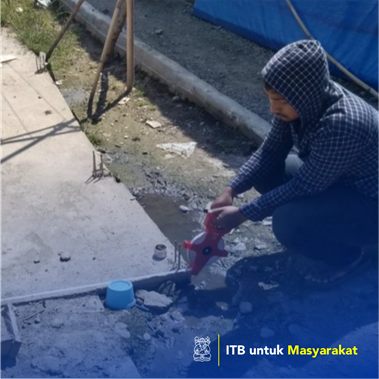

Agus Jatnika Effendi
Indonesia is one of the countries that has a high potential for occurrence natural disasters. One of the territories of Indonesia which stores the potential of natural disasters Large enough is a hammer city and its surroundings. This is caused in the area of ​​Palu City and The surroundings there are several cesarean sections that have the potential to generate a strong enough earthquake. September 28, 2018 Natural disasters that hit the city of Palu and its surroundings, the number of bathing facilities, washing, latrines (MCK) in various ride locations of earthquakes and tsunamis in Palu and Donggala were very limited. If the sanitation issue is not immediately addressed, refugees are feared to contract various disease outbreaks and can increase mortality. Therefore, the issue of post-disaster sanitation must be considered so as not to cause these things. One effort to management of domestic waste water is the procurement of installation Wastewater treatment (IPAL) of the region in the temporary occupancy area (Huntara). At this time There are IPAL areas per Huntara Unit with a capacity of approximately 3 m3 / day serving 20 families using anaerobic baffled reactor (ABR) technology or some use septic tanks. However, in practice, the design used is not entirely appropriate with conditions in the field, resulting in the WWTP to be full of full or wastewater not to experience processing at all. This community service program is intended to obtain the concept of processing design and waste water management in temporary occupancy areas (Huntara) and fixed occupancy (Huntap) to be fulfilled optimum conditions for domestic wastewater treatment in the area.
Application of appropriate technology
On September 28, 2018 there was a natural disaster that hit the city of Palu and its surroundings, The disaster is in the form of an earthquake, tsunami, and liquefaction. Based on the data obtained from the Ministry of Health and the National Disaster Management Agency (BNPB), up to October 3, 2018 at 8:00 p.m. (19.00 WIB) recorded 1,407 deaths, 311 lost victims, 2,549 victims suffered serious injuries / inpatient, 0 victims were injured Lightweight / outpatient, and 70,821 refugees spread across 141 points. The number of bath facilities, washing, Lakus (MCK) in various ride locations of the earthquake and tsunami in Palu and Donggala are very limited. If the sanitation issue is not immediately addressed, the refugees are feared to be infected Various disease outbreaks and can increase mortality. Therefore, the problem regarding post-disaster sanitation must be considered so as not to cause things the.